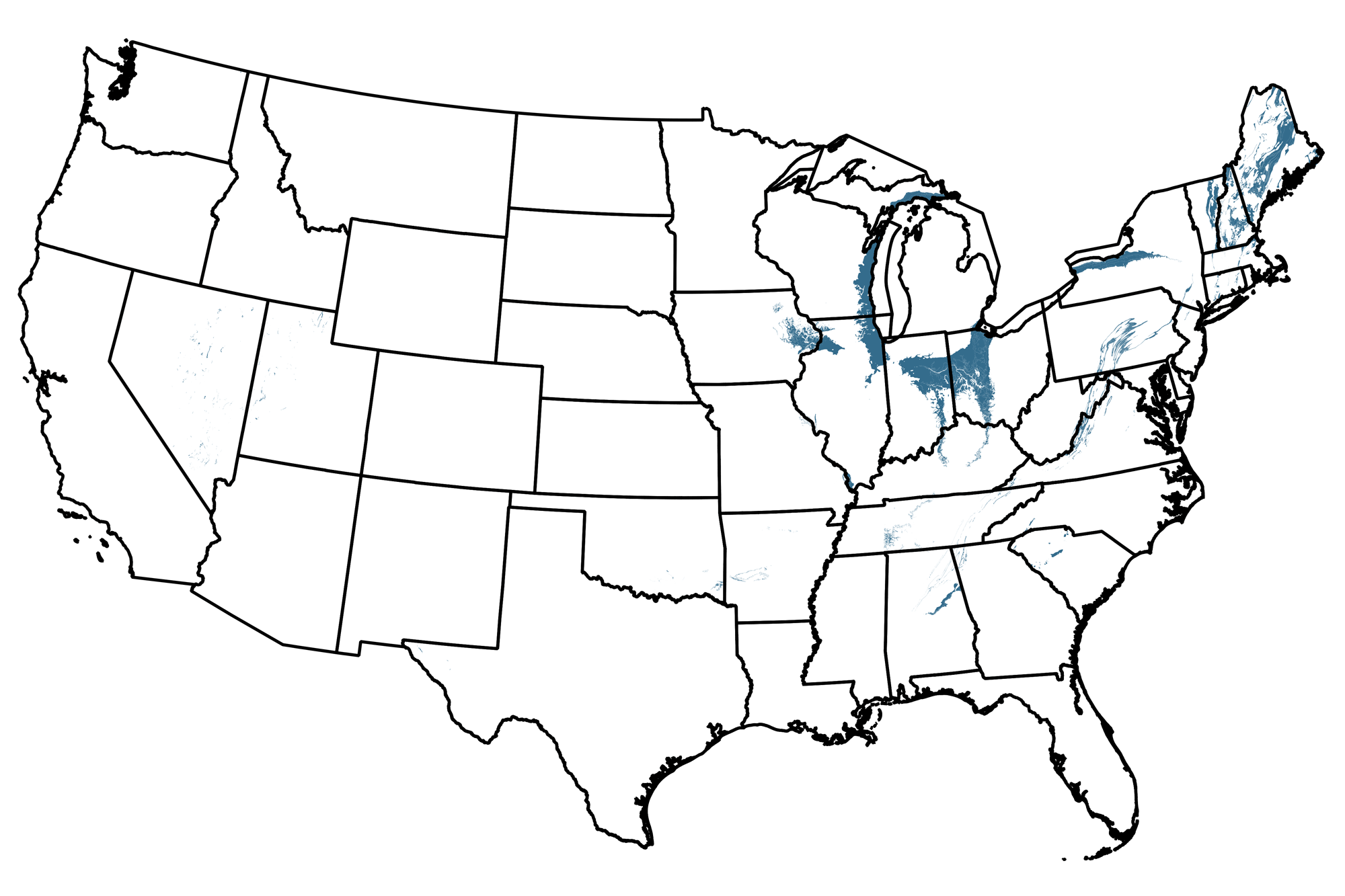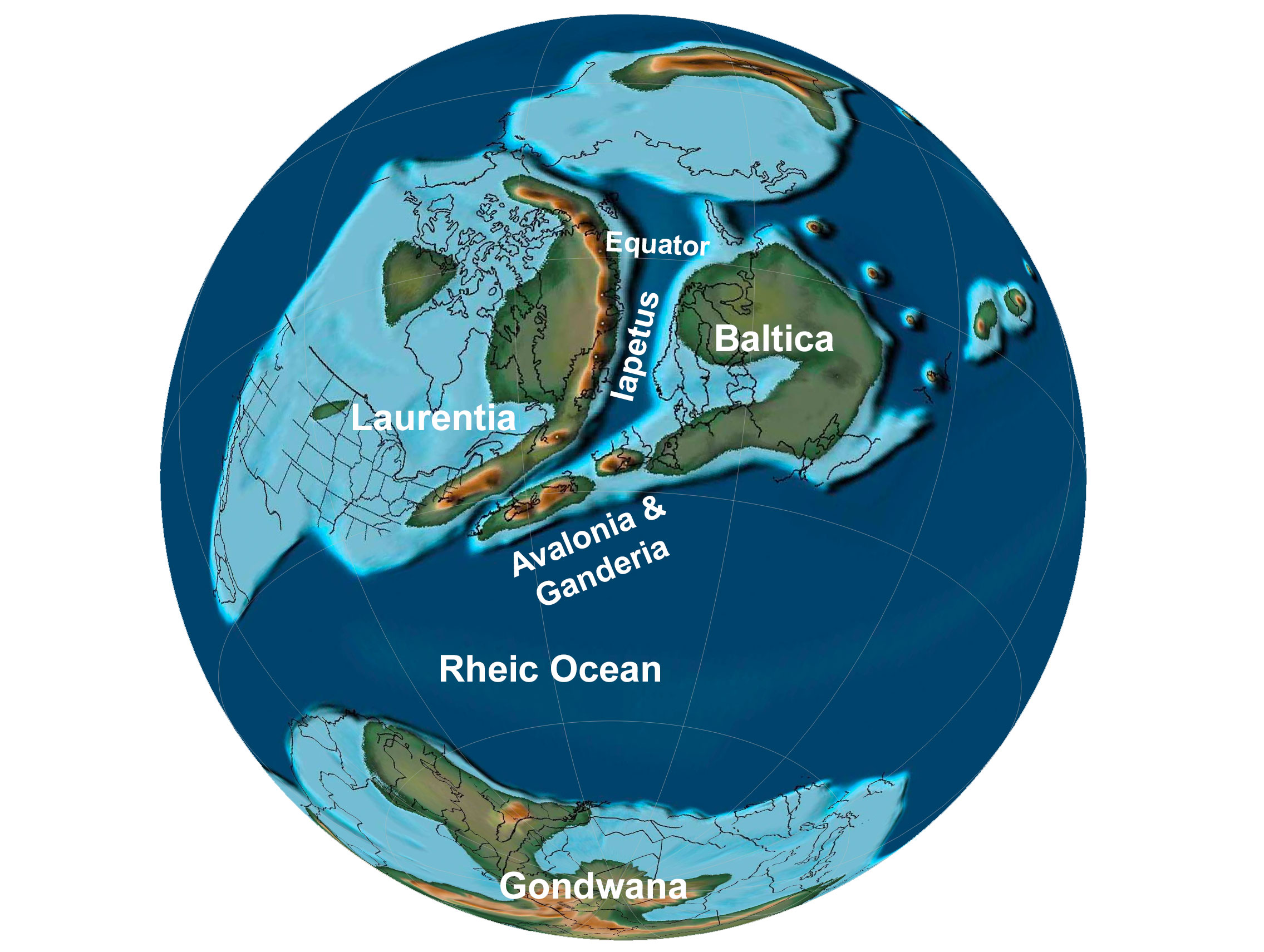Page overview: Examples of common types of Silurian fossils from the United States.
Additional related resources on Earth@Home:
- Geologic Time Scale
- Quick Guide to Common Fossils
- Fossils of the United States
- Fossils of the Central Lowland region of the Midwestern United States
Page last updated November 4, 2022.

Locations (in blue) of Silurian bedrock in the United States. Map created using QGIS and USGS data from Horton et al. (2017) using the maximum age values for each mapped unit. All images have a Creative Commons Attribution-NonCommercial-ShareAlike 4.0 International license. You are welcome to use it for any non-commercial educational purpose.
Highlights of Silurian Life
Diorama of Silurian marine life, once displayed at the Smithsonian Institution’s National Museum of Natural History. The diorama is now housed at the Paleontological Research Institution, Ithaca, New York. Learn more about this and other Smithsonian dioramas now at PRI at: https://www.priweb.org/blog-post/vanished-worlds. Model by Emily Hauf.
Fossil Record:
- Famous fossil Lagerstätte: Waukesha Biota (near Milwaukee, WI).
- First vascular plants on land (e.g., Cooksonia and Baragwanathia).
- First animals on land (arthropods).
- First fish with jaws.
- First bony fish (Osteichthyes)
- Sea scorpions (eurypterids) plentiful.
Earth History:
- Passive margin in eastern Laurentia.
- Warm conditions; evaporation of shallow inland seas formed large deposits of evaporites such as salt.
- Shallow seas covered much of the continents.

Earth 430 million years ago, during the middle of the Silurian period. The Iapetus Ocean was closing as Baltica, Avalonia, and Ganderia neared the margin of Laurentia . Reconstruction created using basemap from the PALEOMAP PaleoAtlas for GPlates and the PaleoData Plotter Program, PALEOMAP Project by C. R. Scotese (2016); map annotations by Elizabeth J. Hermsen for PRI's Earth@Home project (CC BY-NC-SA 4.0 license).
Sponges
Stromatoporoids
Fossil specimen of the stromatoporoid Stromatopora sp. from the Silurian Lilley Dolomite Highland County, Ohio (T-261/PRI 43408). Specimen is from the teaching collection of the Paleontological Research Institution, Ithaca, New York. Longest dimension of specimen is approximately 13 cm. Model by Emily Hauf.
Calcareous sponges
Fossil specimen of the sponge Astraeospongium meniscus from the Silurian Niagara Group of Perry County, Tennessee (PRI 76744). Specimen is from the collections of the Paleontological Research Institution, Ithaca, New York. Maximum diameter of specimen is approximately 8 cm. Model by Emily Hauf.
Corals
Tabulate Corals
Favosites ("Honeycomb Coral")
Fossil specimen of the tabulate coral Favosites favosus from the Silurian of Delaware County, Iowa (PRI 76737). Length of specimen is approximately 10 cm. Specimen is from the collections of the Paleontological Research Institution, Ithaca, New York. Model by Emily Hauf.
Favosites, a tabulate coral fossil from the Silurian of Wisconsin. Longest dimension of specimen is approximately 16 cm. Model by Jonathan R. Hendricks. A YouTube video about this fossil is below.
"Fossils@Home #2: Tabulate Corals" by Paleontological Research Institution (YouTube). A 3D model of this specimen is above.
Halysites ("Chain Coral")
Fossil specimen of the tabulate coral Halysites catenularia from the Silurian of Jefferson County, Kentucky (PRI 76738). Specimen is from the collections of the Paleontological Research Institution, Ithaca, New York. Maximum dimension of specimen is approximately 5 cm. Model by Emily Hauf.
Fossil specimen of the tabulate “chain coral” Halysites catenularia from the Silurian period (PRI 70775). Specimen is from the collections of the Paleontological Research Institution, Ithaca, New York. Longest dimension of specimen is approximately 24 cm. Model by Emily Hauf.
Brachiopods
Fossil specimen of the brachiopod Pentamerus oblongus from the Silurian Waukesha Formation of Jackson County, Iowa (PRI 70760). Specimen is from the collections of the Paleontological Research Institution, Ithaca, New York. Specimen is approximately 5.5 cm in length. Model by Emily Hauf.
Snails (Gastropods)
Fossil specimen of the gastropod Platyceras niagarensis from the Silurian Waldron Shale of Shelby County, Indiana (PRI 76748). Specimen is from the collections of the Paleontological Research Institution, Ithaca, New York. Longest dimension of specimen is approximately 5 cm. Model by Emily Hauf.
Trilobites
Fossil specimen of the trilobite Calymene celebra from the Silurian Niagara Series of Milwaukee, Wisconsin (PRI 42100). Specimen is from the collections of the Paleontological Research Institution, Ithaca, New York. Specimen is approximately 4 cm in length. Model by Emily Hauf.
Fossil specimen of the trilobite Dalmanites sp. from the Silurian of Niagara County, New York (PRI 76797). Specimen is from the collections of the Paleontological Research Institution, Ithaca, New York. Length of specimen (not including surrounding rock) is approximately 5 cm. Model by Emily Hauf.
Sea Scorpions (Eurypterids)
This diorama depicts a variety of Silurian-aged eurypterids, or sea scorpions. The diorama was created in 1980 and formerly displayed at the Smithsonian Institution’s National Museum of Natural History prior to being transferred to the Paleontological Research Instititution (Ithaca, NY) in 2015.
Fossil specimen of the eurypterid Eurypterus remipes from the Silurian of Herkimer County, New York. Specimen is from the collections of the Paleontological Research Institution, Ithaca, New York. Model by Emily Hauf.
Fossil eurypterid (sea scorpion) Dolichopterus macrocheirus from the Silurian of Herkimer County, New York (PRI 42894). Specimen is on display at the Museum of the Earth, Ithaca, New York. Length of preserved portion of specimen is approximately 18.5 cm in length. Model by Emily Hauf.
Fossil eurypterid (sea scorpion) Pterygotus sp. claw from the Silurian Bertie Formation of Herkimer County, New York (PRI 50322). Specimen is on display at the Museum of the Earth, Ithaca, New York. Length of claw is approximately 9.5 cm. Model by Emily Hauf.
Crinoids
Specimen of the crinoid Eucalyptocrinites caelatus from the Silurian period of Niagara County, New York (PRI 70772). Specimen is from the collections of the Paleontological Research Institution, Ithaca, New York. Specimen is approximately 5 cm in length and represents the calyx and arms of the crinoid animal.
Graptolites
Fossil specimens of the graptolite Monograptus clintonensis from the Silurian Williamson Shale of Rochester, New York (PRI76765). Specimen is from the collections of the Paleontological Research Institution, Ithaca, New York. Maximum dimension of rock is 11.5 cm. Model by Emily Hauf.
Fossil graptolite Palaeodictyota anastomotica from the Silurian of Niagara County, New York (PRI 49831). This specimen is preserved as a carbonization. Specimen is on display at the Museum of the Earth, Ithaca, New York. Diameter of specimen is approximately 8.5 cm. Model by Emily Hauf.
Trace Fossils
Trace fossils include the tracks and burrows left behind by ancient animals.
Trace fossil (or, ichnofossil) specimen of Arthrophycus alleghaniensis from the Silurian Medina Limestone of Orleans County, New York (PRI 76756). The animal that made these feeding traces may have been an arthropod. Specimen is from the collections of the Paleontological Research Institution, Ithaca, New York. Maximum dimension of specimen is approximately 12.5 cm. Model by Emily Hauf.
Trace fossil specimen of Rusophycus bilobatus from the Silurian Rose Hill Shale of Scott County, Virginia (PRI 76852). This resting trace was likely made by a trilobite. Specimen is from the research collections of the Paleontological Research Institution, Ithaca, New York. Longest dimension of rock is approximately 9.5 cm. Model by Emily Hauf.



